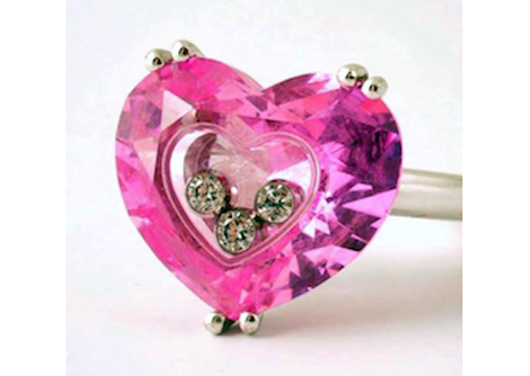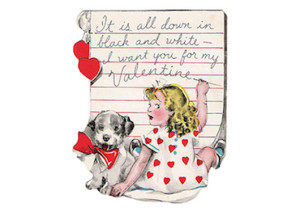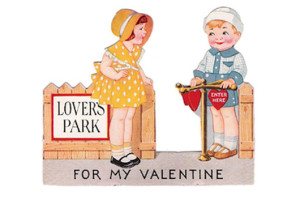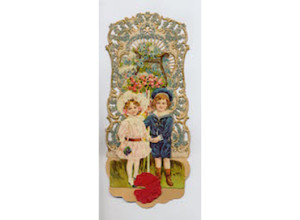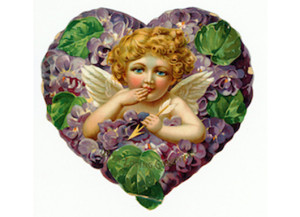LONDON – High Street shops up and down the land are touting gifts for Valentine’s Day and antiques dealers and fairs organizers are no different: There’ll be a selection to suit pockets of all breadth and depth, whether it’s a heart-shaped diamond brooch, or a Victorian or Edwardian card with fewer noughts.
I’m in the latter camp and I’ll be [window] shopping at Chester Antiques & Fine Art Show this weekend, which happily coincides with the day itself. Coincidentally, it’s also the business manager (Mrs. P’s) birthday, so it might have proved expensive, had it not been for the fact that she is elsewhere that weekend.
Chocolates might have to suffice because in truth, we already have a little collection of valentine cards, the earliest of which is little Georgian hand-painted example called “The Rivals.” In the center are two suitors for the hand of the recipient who are squaring up to each other for a bout of fisticuffs to decide who will have the pleasure of her hand in marriage.
In fact, valentine greetings have been popular since the Middle Ages, when prospective lovers recited or sang their romantic verses.
The first written valentine is traditionally attributed to the imprisoned Charles, Duke of Orleans, in 1415. While confined in the Tower of London after the Battle of Agincourt, the young man reportedly passed his time by writing romantic verses for his wife in France. Approximately 60 of his poems survive and can be seen among the royal papers in the British Museum.
The idea caught lovers’ imagination. By the 1500s written cards had replaced gifts or “poetical or amorous addresses” and were particularly popular in England.
By the 16th century, written valentines were commonplace and by the 17th, it was a widespread tradition in England and other Western countries for friends and sweethearts to exchange gifts and notes on Feb. 14.
In the early 1700s, Charles II of Sweden brought the Persian poetical art known as the “Language of Flowers” to Europe, after which floral dictionaries were published, permitting the exchange of romantic secrets via a single flower, while a bouquet could take the place of an entire love letter.
The more popular the flower, the more traditions and meaning were associated with it. The red rose, believed to be the favored flower of Venus, the Roman Goddess of Love, became universally accepted to represent romance and so, the custom of giving red roses on Valentine’s Day quickly gained popularity.
The popularity of valentine cards in America began to grow some time after 1723 with the import from England of “valentine writers.” A writer was the name given to booklets comprising a vast array of verses and messages that could be copied onto gilt-edged paper or other type of decorative sheet.
One popular “writer” contained not only “Be My Valentine” types of verses for the men to send to their sweethearts, but also acceptances or “answers” which the ladies could return.
Late 18th century and early 19th century valentines were often religious in nature and it is possible that the “Sacred Heart” often depicted on these cards eventually became the “valentine heart” with the customarily accompanying Angel eventually becoming Cupid.
It is believed that earlier versions of these religious valentines may have been made by nuns who would cut out the paper lace with scissors. The process must have taken many days since the cards are so fine and intricate that they appear to be machine-made.
Other early 19th century valentines made by hand employed a variety of materials including honeycombed tissue, watercolors, paper puffs, colored inks, embossed paper hearts and exquisite lace. These were truly beautifully created small works of art, often adorned with silk or satin in addition to lace, flowers or feathers and even gold leaf. Such fragile honeycomb designs remained the vogue until around 1909.
Valentines are also closely related to Austrian and German love tokens which were produced until around 1820. Exquisitely made, these little items were fashioned and colored totally by hand. Not necessarily given on Valentine’s Day, they were adorned with hearts and images of sweethearts. Many had a transparent net background embossed with gold trimmings.
However, by the early 1800s, most valentine cards were printed on commercial lines. Early manufactured valentines were somewhat simplistic, composed of black-and-white pictures painted by the factory workers.
More fancy printed valentines with real lace and ribbons were introduced in the mid-1800s. These also contained delicate and artistic messages with such pictures as turtledoves; lovers’ knots in gold or silver; bows and arrow; Cupids and bleeding hearts.
The introduction of the Uniform Penny Post in 1840 saw the introduction of “penny postcards” valentine greetings, which proved highly popular from around 1890 to 1917. The 1840s also saw the first “mechanical” valentines. By pulling a tab, a figure or object on the card could be made to move. Some even had elaborate and dramatic pop-outs or other three-dimensional features.
England saw the first commercial valentines produced on embossed paper, later perforated to make designs imitating elaborate lace. Some contained tiny mirrors with the message: “Look at my Beloved,” while others were called “cobweb valentines” because the center could be lifted by a tassel to reveal a cobweb effect of paper and underneath, a picture of a couple or a romantic message.
Pre-Victorian valentines are expensive and difficult to find today. An elaborate card from this era probably cost the sender as much as a month’s earnings, particularly the “proposal valentines,” which might contain the depiction of a church or a ring. In keeping with Victorian etiquette, it was considered improper for a lady to send a valentine greeting to a man.
Later mass-produced examples are more readily available, with prices starting in the low double figures.
___
A number of late 19th and early 20th century valentines cards will be on sale with exhibitor Altus Arts at Chester Antiques and Fine Art Show. Held in the County Grandstand at Chester Racecourse, it runs from Thursday, Feb. 12, to Sunday, Feb. 15.
Fifty leading antiques dealers from across the Northwest, England and Wales will be showing a wide range add antiques and fine art, all vetted for authenticity, together with a wide range of unique and memorable valentine’s gifts with prices to suit every pocket, from less than £50 to more than £5,000.
Entry is £5 (including parking).



